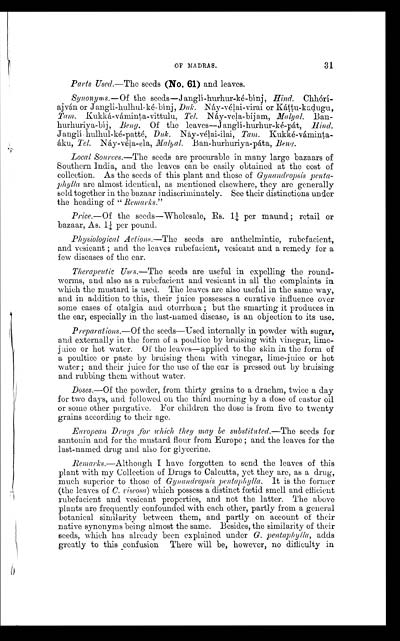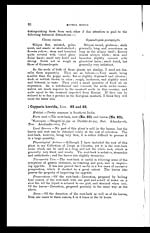Medicine - Drugs > Materia medica of Madras volume I > Vegetable kingdom
(47) Page 31
Download files
Individual page:
Thumbnail gallery: Grid view | List view

OF MADRAS.
31
Parts Used.—The seeds (No. 61) and leaves.
Synonyms.— Of the seeds—Janglí-hurhur-ké-bínj, Hind. Chhórí-
ajván or Jangli-hulhul-ké-bínj, Duk. Náy-vélai-virai or Káttu-kadugu,
Tam. Kukká-váminta- Vittulu, Tel. Náy-vela-bíjam, Malyal. Ban-
hurhuriya-bíj, Beng. Of the leaves—Janglí-hurhur-ké-pát, Hind.
Janglí-hulhul-ké-patté, Duk. Náy-vélai-ilai, Tam. Kukké-váminta-
áku, Tel. Náy-véla-ela, Malyal. Ban-hurhuriya-páta, Beng.
Local Sources.—The seeds are procurable in many large bazaars of
Southern India, and the leaves can be easily obtained at the cost of
collection. As the seeds of this plant and those of Gynandropsis penta-
phylla are almost identical, as mentioned elsewhere, they are generally
sold together in the bazaar indiscriminately. See their distinctions under
the heading of "Remarks."
Price.—Of the seeds—Wholesale, Rs. 1¼ per maund; retail or
bazaar, As. 1¼ per pound.
Physiological Actions.—The seeds are anthelmintic, rubefacient,
and vesicant; and the leaves rubefacient, vesicant and a remedy for a
few diseases of the ear.
Therapeutic Uses.—The seeds are useful in expelling the round-
worms, and also as a rubefacient and vesicant in all the complaints in
which the mustard is used. The leaves are also useful in the same way,
and in addition to this, their juice possesses a curative influence over
some cases of otalgia and otorrhœa; but the smarting it produces in
the ear, especially in the last-named disease, is an objection to its use.
Preparations.—Of the seeds—Used internally in powder with sugar,
and externally in the form of a poultice by bruising with vinegar, lime-
juice or hot water. Of the leaves—applied to the skin in the form of
a poultice or paste by bruising them with vinegar, lime-juice or hot
water; and their juice for the use of the ear is pressed out by bruising
and rubbing them without water.
Doses.—Of the powder, from thirty grains to a drachm, twice a day
for two days, and followed on the third morning by a dose of castor oil
or some other purgative. For children the dose is from five to twenty
grains according to their age.
European Drugs for which they may be substituted.—The seeds for
santonin and for the mustard flour from Europe; and the leaves for the
last-named drug and also for glycerine.
Remarks.—Although I have forgotten to send the leaves of this
plant with my Collection of Drugs to Calcutta, yet they are, as a drug,
much superior to those of Gynandropsis pentaphylla. It is the former
(the leaves of C. viscosa) which possess a distinct fœtid smell and efficient
rubefacient and vesicant properties, and not the latter. The above
plants are frequently confounded with each other, partly from a general
botanical similarity between them, and partly on account of their
native synonyms being almost the same. Besides, the similarity of their
seeds, which has already been explained under G. pentaphylla, adds
greatly to this confusion There will be, however, no difficulty in
Set display mode to: Large image | Zoom image | Transcription
Images and transcriptions on this page, including medium image downloads, may be used under the Creative Commons Attribution 4.0 International Licence unless otherwise stated. ![]()
| India Papers > Medicine - Drugs > Materia medica of Madras volume I > Vegetable kingdom > (47) Page 31 |
|---|
| Permanent URL | https://digital.nls.uk/74907654 |
|---|




